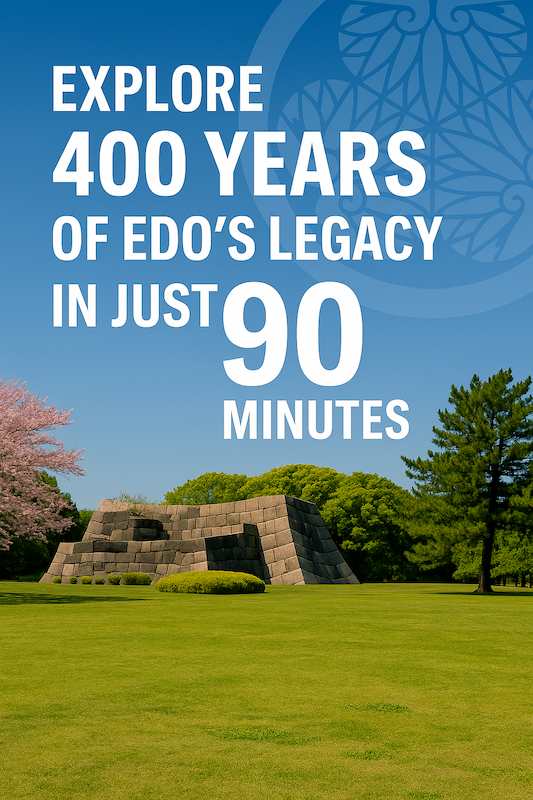
Explore 400 Years of Edo’s Legacy in Just 90 Minutes
Explore the heart of Tokyo through this carefully curated walking tour of the Edo Castle Ruins in the East Gardens of the Imperial Palace. Designed for first-time visitors and casual history fans, this guide highlights seven of the most visually stunning, historically rich, and easy-to-navigate locations.
From iconic gates and towering watchtowers to tranquil gardens and samurai guardhouses, each stop offers a unique window into Japan’s feudal past—all within just 90 minutes. Get ready for a journey where ancient history meets modern serenity.
1.Otemon Gate
⭐Recommendation Rating
Historical Significance: ☆☆
Visual Appeal: ☆☆☆
Experiential Value: ☆☆☆
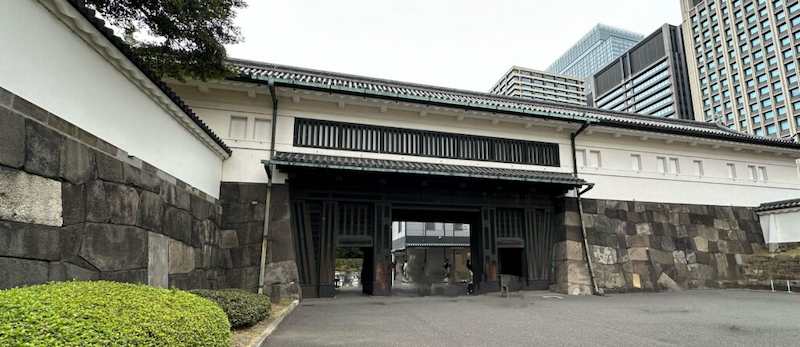
Otemon Gate, originally built in 1607 by the renowned castle architect Todo Takatora, served as the main entrance to Edo Castle. In the 1620 reconstruction under Sakai Tadatsuyo, the left and right stone walls were built by Date Masamune. The gate was heavily fortified, guarded by 30 muskets, 10 bows, and 20 long spears, ensuring strict security around the castle.
| Year Built | 1607 (Keichō 12) |
|---|---|
| Builder | Tōdō Takatora |
| Structure/Features | Masugata-style gate with Kōraimon and Watari-yagura |
| Renovation/Restoration | In 1620, Sakai Tadayoshi handled construction; Date Masamune built the stone walls |
| Current Status | Kōraimon remains; Watari-yagura rebuilt in wood in 1963 |
| Destruction/Damage | Watari-yagura destroyed in WWII air raids |
| Cultural Property Designation | Tokyo Metropolitan Tangible Cultural Property (1995) |
| Remarks | – |
🗺 Address: 1-1 Chiyoda, Chiyoda-ku, Tokyo
🚶 Access:
- a 5-minute walk from Otemachi Station on the Tokyo Metro Tozai Line (approx. 0.4km)
⏳ Recommended Visit Duration:
- Quick sightseeing: ~15 minutes
- In-depth exploration: ~30 minutes
📍 Key Highlights
- Koraimon Gate: A historic structure from the Edo period, showcasing advanced architectural techniques of the time.
- Masugata Courtyard: A square-shaped defensive feature designed to slow enemy advances, allowing visitors to experience its strategic design firsthand.
- Restored Watariyagura Gate: Originally destroyed during wartime, this wooden structure was reconstructed in 1963, preserving the gate’s historical appearance.
- Stone Walls: Edo-period stone walls remain intact, offering a glimpse into past construction methods.
- Seasonal Attractions: During spring, cherry blossoms bloom around the gate, creating a picturesque scene.
📌 Trivia
- Historical Significance: Otemon served as the main entrance for shoguns, imperial messengers, and feudal lords, with stringent security measures in place.
- Connection to Famous Figures: The construction involved prominent samurai lords, including Todo Takatora and Date Masamune.
2.Sannomaru Shozokan
⭐Recommendation Rating
Historical Significance: ☆
Visual Appeal: ☆☆
Experiential Value: ☆☆☆
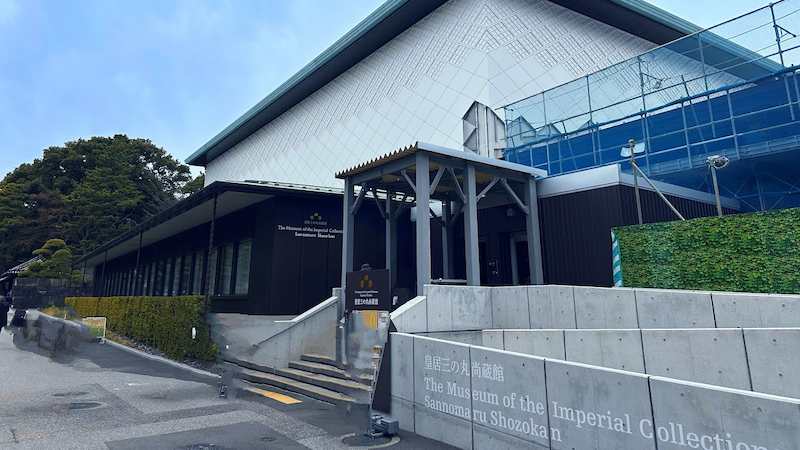
Located within the East Gardens of the Imperial Palace, the Sannomaru Shozokan is an art museum showcasing imperial treasures. Opened in 1993, it houses approximately 9,800 works, including national treasures by artists such as Ito Jakuchu and Kano Eitoku. As exhibits change periodically, there is no permanent display, ensuring a fresh experience with each visit.
| Year Built | 1993 (Heisei 5) |
|---|---|
| Builder | Imperial Household Agency |
| Structure/Features | A museum exhibiting imperial art treasures. Exhibitions change regularly; no permanent display. |
| Renovation/Restoration | New facility opened in 2023; management transferred to the National Institutes for Cultural Heritage. |
| Current Status | Still standing |
| Destruction/Damage | None |
| Cultural Property Designation | None |
| Remarks | – |
🗺 Address: 1-1 Chiyoda, Chiyoda-ku, Tokyo
💰 Admission: 1,000 yen (as of March 15, 2025; check the official link for updates)
🚶 Access:
- a 1-minute walk from Otemon Gate (approx. 80m)
⏳ Recommended Visit Duration:
- Quick sightseeing: ~15 minutes
- In-depth exploration: ~40 minutes
📍 Key Highlights
- National Treasures: View masterpieces such as Ito Jakuchu’s Colorful Realm of Living Beings and Kano Eitoku’s Karajishi Folding Screen.
- Seasonal Exhibits: Rotating special exhibitions allow visitors to discover different works each visit.
📌 Trivia
- Historical Background: Established following the donation of imperial art collections to the nation after Emperor Showa’s passing.
- Hidden Gem: A storage area housing rarely seen artworks is occasionally accessible during special events.
- Connection to Renowned Artists: Features works by renowned Japanese artists such as Yokoyama Taikan and Takamura Koun.
3.Hyakunin Guardhouse
⭐Recommendation Rating
Historical Significance: ☆☆
Visual Appeal: ☆☆☆
Experiential Value: ☆
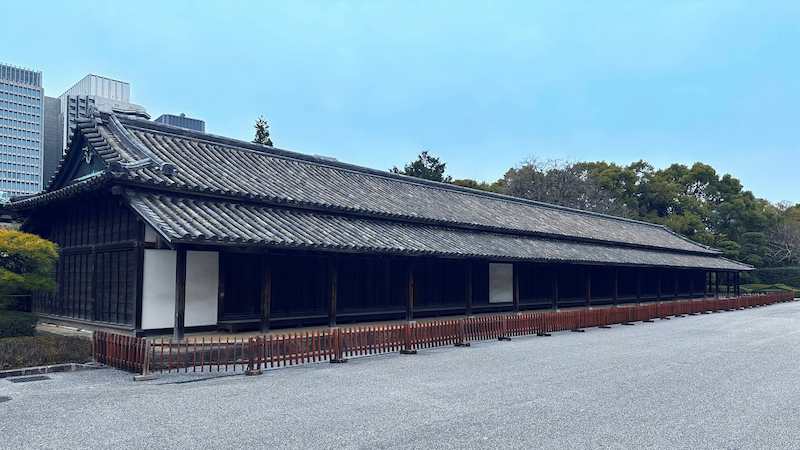
The Hyakunin Guardhouse is the largest of Edo Castle’s three surviving security posts, manned by the Hyakunin-gumi, an elite gunner squad responsible for castle defense.
| Year Built | Early Edo period (exact year unknown) |
|---|---|
| Builder | Tokugawa Shogunate |
| Structure/Features | Approx. 50 meters long; row-house style with visible Edo-era architectural techniques. |
| Renovation/Restoration | Restored in 1968 to its original Edo period form. |
| Current Status | Still existing |
| Destruction/Damage | None |
| Cultural Property Designation | None |
| Remarks | Home to elite gunmen units (Iga, Kōga, Negoro, and 25 Riders Group) tasked with protecting the castle. |
🗺 Address: 1-1 Chiyoda, Chiyoda-ku, Tokyo
🚶 Access:
- 2 minute walk from Sannomaru Shozokan (approx. 170m)
⏳ Recommended Visit Duration:
- Quick sightseeing: ~5 minutes
- In-depth exploration: ~15 minutes
📍 Key Highlights
- Edo-Period Architecture: The longhouse structure, spanning approximately 50 meters, retains original Edo-era construction techniques.
- Defensive Layout: The interconnected rooms illustrate the scale of security operations during the shogunate.
- Preserved Stone Walls: Surrounding fortifications highlight Edo Castle’s sophisticated defense system.
📌 Trivia
- Historical Role: The Hyakunin-gumi gunners stationed here played a critical role in Edo Castle’s security.
4.Nakanomon Gate Ruins
⭐ Recommended Rating
Historical :☆☆
Visual value:☆☆☆
Experiential:☆☆
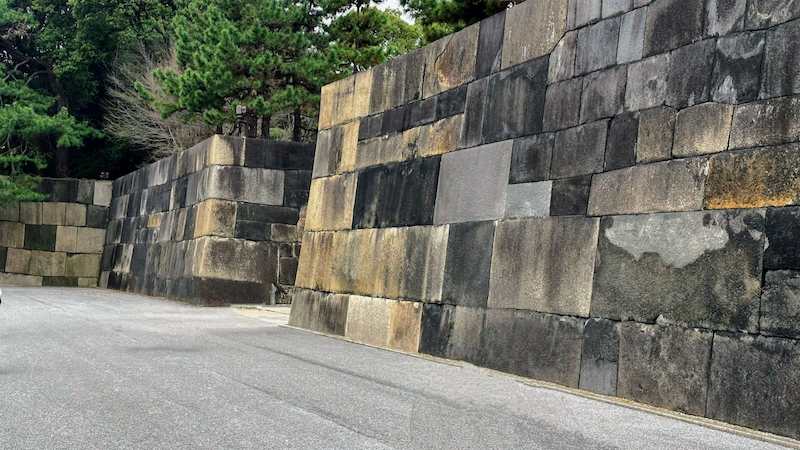
The Nakanomon Gate once served as a major entrance to the Honmaru of Edo Castle. Throughout the Edo period, it was used by shoguns and feudal lords upon their arrival at the castle, and its strategic importance warranted strict security. Today, only the stone walls remain, offering a glimpse into the gate’s once-imposing structure.
| Item | Content |
|---|---|
| Year Built | Unknown |
| Builder | Unknown |
| Structure/Features | Remains of a gate; only stone walls survive |
| Renovation/Restoration | Unknown |
| Current Status | Stone walls remain |
| Destruction/Damage | Upper gate structure lost |
| Cultural Property Designation | Unknown |
| Remarks | – |
🗺 Address: 1-1 Chiyoda, Chiyoda-ku, Tokyo
🚶 Access: a 1-minute walk from Hyakuninbansho (approx. 0.05km)
⏳ Recommended Visit Duration:
- Quick visit: About 5 minutes
- In-depth exploration: About 15 minutes
📍 Highlights
- Stone Wall Engineering: The Nakanomon ruins showcase the sophisticated stone masonry techniques of the Edo period.
- Surrounding Historical Structures: Nearby, you can also visit the Hyakunin-bansho and Obansho guardhouses to gain a deeper understanding of the castle’s security system.
📌 Trivia
- A Strategic Defense Point: The Nakanomon Gate was a heavily fortified area, crucial for the castle’s defense.
- Hidden Details: Some stones bear engravings of daimyo crests, indicating the clans responsible for maintenance and repairs.
5.Fujimi Yagura (Tower)
⭐ Recommended Rating
Historical :☆☆☆
Visual value:☆☆☆
Experiential:☆☆☆
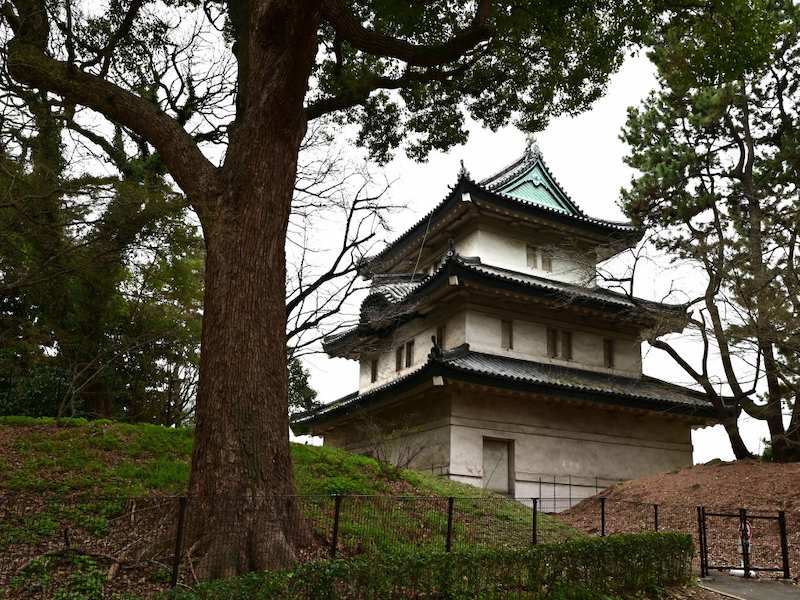
The Fujimi Yagura is one of the few remaining original structures of Edo Castle. This three-tiered watchtower, built in the early Edo period, was strategically placed for surveillance and defense. It was named “Fujimi” because, in the past, one could see Mount Fuji from its upper levels.
| Item | Content |
|---|---|
| Year Built | Early Edo Period |
| Builder | Tokugawa Ieyasu |
| Structure/Features | Three-story turret with white plaster walls and black tiles |
| Renovation/Restoration | Unknown |
| Current Status | Still existing |
| Destruction/Damage | Unknown |
| Cultural Property Designation | Unknown |
| Remarks | – |
🗺 Address: 1-1 Chiyoda, Chiyoda-ku, Tokyo
🚶 Access:a 4-minutes walk from Nakanomon Gate Ruins (about 180m)
⏳ Recommended Visit Duration:
- Quick visit: About 10 minutes
- In-depth exploration: About 20 minutes
📍 Highlights
- Striking Architecture: The contrast of white walls and black roof tiles showcases Edo-period aesthetics.
- Fortified Stone Walls: The sturdy base demonstrates the advanced construction techniques of the era.
- Seasonal Charm: Cherry blossoms in spring create a breathtaking scene with the watchtower.
📌 Trivia
- Symbol of Edo Castle: After the 1657 Great Fire of Meireki destroyed the main keep, the Fujimi Yagura became the de facto symbol of Edo Castle.
- Lost View of Mount Fuji: While the watchtower was originally named for its scenic view, modern buildings now obstruct the sightline.
6.Site of Edo Castle Tenshudai (Main Keep Foundation)
⭐ Recommended Rating
Historical :☆☆☆
Visual value:☆☆☆
Experiential:☆☆☆
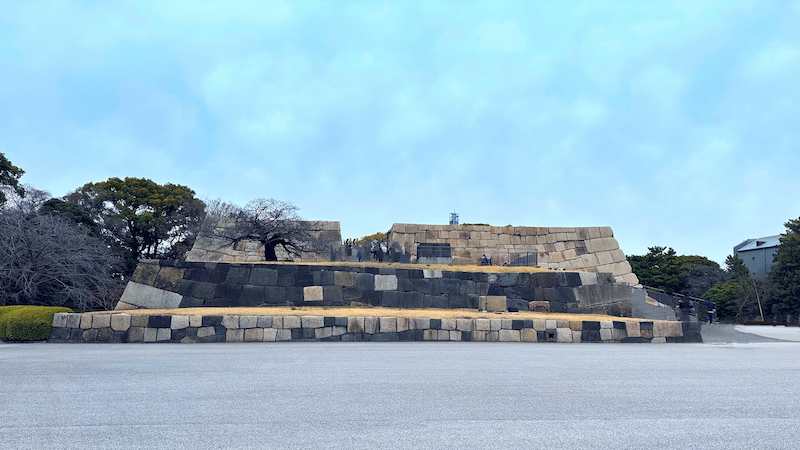
The Edo Castle tenshudai marks the site where the castle’s main keep once stood. Although the tenshu was rebuilt three times throughout the Edo period, it was ultimately destroyed in the Great Meireki Fire of 1657 and never reconstructed. Today, only the stone foundation remains, situated within the East Gardens of the Imperial Palace, serving as a testament to the castle’s grandeur.
| Item | Content |
|---|---|
| Year Built | 1607 (Keichō 12) |
| Builder | Tokugawa Ieyasu |
| Structure/Features | Stone base approx. 11m tall and 41m wide |
| Renovation/Restoration | None |
| Current Status | Stone base still remains |
| Destruction/Damage | Keep destroyed in the 1657 Great Fire of Meireki |
| Cultural Property Designation | Unknown |
| Remarks | – |
🗺 Address: 1-1 Chiyoda, Chiyoda-ku, Tokyo
🚶 Access
a 9-minutes walk from Fujimi Yagura (about 700m)
⏳ Recommended Visit Duration
Quick visit: About 10 minutes
For a more in-depth experience: About 20 minutes
📍 Highlights
- Tenshudai Stone Foundation: Standing 11 meters tall and 41 meters wide, this massive structure showcases Edo-period stonework techniques.
- Panoramic Views from the Tenshudai: Visitors can enjoy a breathtaking view of the East Gardens of the Imperial Palace and Tokyo’s modern skyline, where history and contemporary life converge.
- Seasonal Beauty: In spring, cherry blossoms create a stunning contrast with the tenshudai’s stone walls.
📌 Trivia
- Unexpected Historical Fact: Plans for rebuilding the tenshu were abandoned due to financial difficulties and political considerations.
- Hidden Historical Spot: The stone foundation still bears the engraved marks of feudal lords who transported the stones, which can be discovered upon close inspection.
- Famous Connection: During discussions about the tenshu’s reconstruction, Hoshina Masayuki, a key Tokugawa advisor, argued that a main keep was not essential, ultimately leading to the project’s cancellation.
7.Ninomaru Garden
⭐ Recommended Rating
Historical :☆☆
Visual value:☆☆☆
Experiential:☆☆
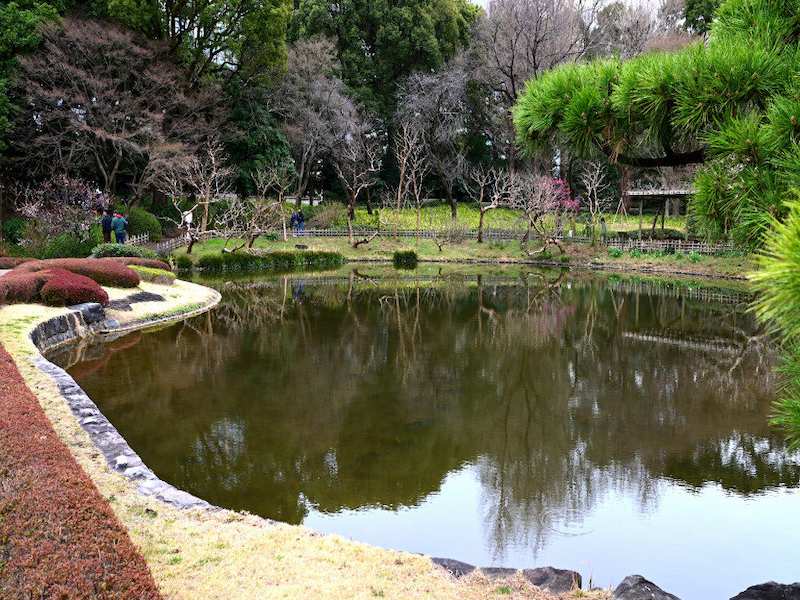
Ninomaru Garden is a pond-centered stroll garden located within the East Gardens of the Imperial Palace. Originally designed by the renowned garden master Kobori Enshu during the early Edo period, it was later renovated under the orders of the third shogun, Tokugawa Iemitsu. Over time, the garden fell into disrepair but was restored in the Showa era based on historical blueprints from the time of the ninth shogun, Tokugawa Ieshige.
In 2018, Emperor Emeritus Akihito and Empress Emerita Michiko released Hirenaga Nishikigoi (long-finned ornamental carp) into the garden’s pond. This unique breed was developed through crossbreeding between Japanese koi and Indonesian long-finned carp, inspired by the then-Crown Prince’s interest in the species in 1977. Visitors today can admire these graceful fish swimming in the pond.
| Item | Content |
|---|---|
| Year Built | Originally designed in 1636; restored in 1968 |
| Builder | Designed by Kobori Enshū |
| Structure/Features | Pond-centered stroll garden with symbolic islands and seasonal flora |
| Renovation/Restoration | Restored in 1968 based on historical blueprints |
| Current Status | Restored garden open to the public |
| Destruction/Damage | Original garden destroyed by fire in 1867 |
| Cultural Property Designation | None |
| Remarks | – |
🗺 Address: 1-1 Chiyoda, Chiyoda-ku, Tokyo
🚶 Access:
a 9-minutes walk from Site of Edo Castle Tenshudai (about 0.8km)
⏳ Suggested Visit Duration:
- Quick visit: About 15 minutes
- In-depth exploration: About 30 minutes
📍 Highlights:
- Pond-Centered Stroll Garden: Designed in the Shoin-style, the garden features a central pond with Horai Island, flanked by symbolic crane and turtle islets.
- Seasonal Flowers: The garden is adorned with cherry blossoms in spring, irises in early summer, and vibrant autumn foliage, creating a stunning seasonal landscape.
- Historical Structures: Traditional stone lanterns and tea houses scattered throughout the garden offer glimpses into Edo-period aesthetics.
📌 Trivia:
- Unexpected Historical Detail: The Ninomaru Garden fell into neglect after the Meiji era but was restored in 1968 (Showa 43), bringing it back to its former glory.
- A Hidden Historical Spot: The pond is home to koi fish, including the special Hirenaga Nishikigoi, which add to the garden’s charm.
- Famous Connections: The garden was designed by Kobori Enshu, a master of landscape architecture and tea ceremony, whose works are still admired across Japan.
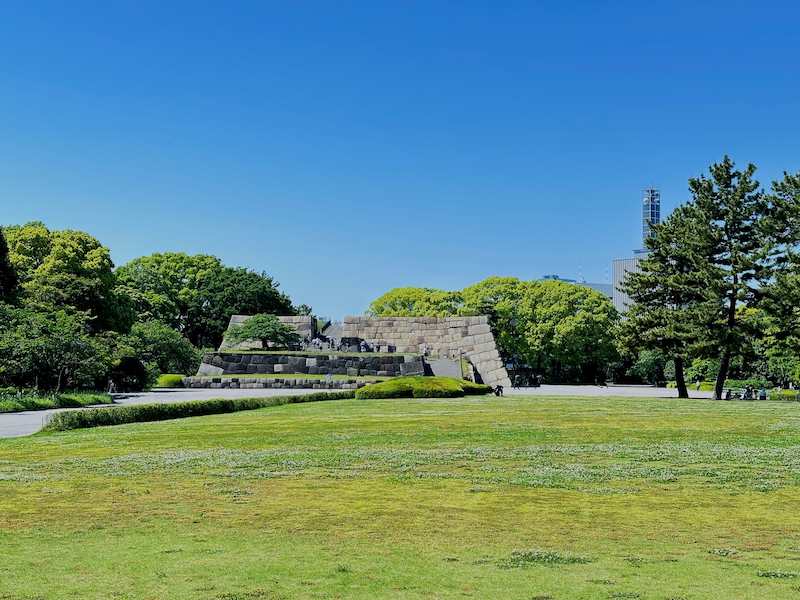



comment